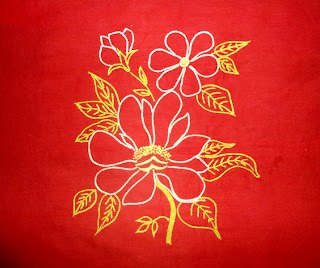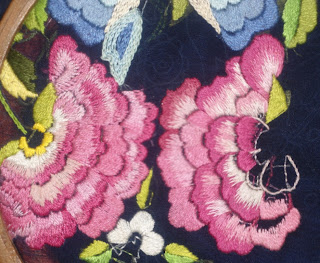Stitch Suggestions
You can interpret this design in several ways, depending on your style and skill level. Here are some ideas to get you started:
For the flowers:
-
Use long and short stitch for the petals to create beautiful shading and depth.
-
If you prefer texture, try fishbone stitch or satin stitch for a more structured look.
-
Outline the petals with a single strand of stem stitch or split stitch to define the edges.
For the flower centers:
-
Try French knots, bullion knots, or seed stitch to add dimension.
-
A touch of gold or metallic thread in the center can add a festive sparkle.
For the leaves:
-
Use fishbone stitch for a classic, natural look.
-
Alternatively, long and short stitch can create a soft shaded effect.
-
You can outline the veins with stem stitch or backstitch in a slightly darker shade of green.
For the stems and buds:
-
Stem stitch, outline stitch, or chain stitch work beautifully for the stems.
-
Use satin stitch or lazy daisy stitch for the small buds.
Color Suggestions
You can personalize this design easily with your favorite color palette. Here are a few ideas:
1. Classic Floral Palette:
-
Petals: Shades of pink (light rose to deep magenta)
-
Leaves: Soft green to olive
-
Stems: Deep moss green
-
Centers: Yellow or gold
2. Soft Pastel Look:
-
Petals: Peach, lilac, or baby blue
-
Leaves: Mint green
-
Stems: Light brown or gray-green
-
Centers: Pale yellow
3. Bold and Bright:
-
Petals: Deep red or royal blue
-
Leaves: Bright green
-
Stems: Dark brown
-
Centers: Metallic gold
Feel free to play with contrasting thread textures — glossy silk, soft cotton, or matte linen threads all create unique results.
✂️ Tips for Using the Pattern
-
Transfer the design to fabric using carbon paper or the lightbox method.
-
Choose a medium-weight cotton or linen base fabric for best results.
-
If you’re new to embroidery, start with two strands of thread — it gives good coverage without bulk.
-
Don’t worry about perfection; the charm of hand embroidery lies in its handmade irregularities.
🌼 Beyond Embroidery
Although this design was created with embroidery in mind, it’s also perfect for:
-
Fabric painting — outline with fabric markers and fill with gentle brush strokes.
-
Appliqué work — use colorful fabric scraps for the petals and leaves.
-
Quilting embellishments — add subtle stitched lines for texture.
This little floral vine is meant to spark creativity — a small pattern to remind you that even the simplest designs can bring great joy when stitched with love.
If you decide to try this pattern, I’d love to see your version! Feel free to share your work or tag me so we can inspire each other throughout the year.
Wishing you happy stitching and a wonderful year ahead filled with colors, creativity, and calm.























